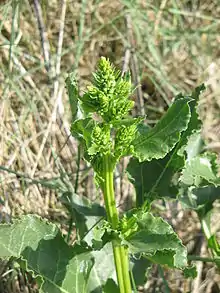| Sea beet | |
|---|---|
 | |
| Scientific classification | |
| Kingdom: | Plantae |
| Clade: | Tracheophytes |
| Clade: | Angiosperms |
| Clade: | Eudicots |
| Order: | Caryophyllales |
| Family: | Amaranthaceae |
| Genus: | Beta |
| Species: | |
| Subspecies: | B. v. subsp. maritima |
| Trinomial name | |
| Beta vulgaris subsp. maritima | |
The sea beet, Beta vulgaris subsp. maritima ((L.) Arcangeli.[1]), is a member of the family Amaranthaceae native to the coasts of Europe, northern Africa, and southern Asia.
The sea beet is the wild ancestor of common vegetables such as beetroot, sugar beet, and Swiss chard. Its leaves have a pleasant texture and taste, being good served raw or cooked, and because of this, it is also known as wild spinach. It is a large perennial plant which grows up to 60 cm (2 ft), and flowers in the summer. Its flowers are hermaphroditic, and wind-pollinated. It requires moist, well-drained soils, and does not tolerate shade. However, it is able to tolerate relatively high levels of sodium in its environment.[2]
Taxonomic history
The species was previously of the Chenopodiaceae. Carl Linnaeus first described Beta vulgaris in 1753; in the second edition of Species Plantarum in 1762, he divided the species into wild and cultivated varieties, giving the name Beta maritima to the wild taxon.[3]
Description
Sea beet is an erect and sprawling perennial plant up to 60 cm (2 ft) high with dark green, leathery, untoothed, shiny leaves. The lower leaves are wavy and roughly triangular while the upper leaves are narrow and oval. The inflorescence is borne on a thick, fleshy grooved stem in a leafy spike. The individual flowers are green and tiny with the sepals thickening and hardening around the fruits.[4]
Distribution and habitat
Sea beet is found in maritime locations in Europe, northern Africa, and southern Asia.[3] In the British Isles it is found round the coasts of England, Wales, Ireland and southern Scotland.[5] It grows at the top of sand and pebble beaches, at the drift-line on saltmarshes, on sea-walls, coastal rocks and cliffs. It also occurs on wasteland near the sea, and occasionally on rubbish tips and roadsides inland.[5] On the pebble banks of Chesil Beach in Dorset, it dominates the drift-line along with oraches Atriplex spp., and is in dynamic equilibrium with a community dominated by shrubby sea-blite Suaeda vera.[6]
References
- ↑ Lange, W., W. A. Brandenburg and T.S.M. De Bock. 1999. Taxonomy and cultonomy of beet (Beta vulgaris L.). Botanical Journal of the Linnean Society 130:81-96.
- ↑ Beta Maritima: The Origin of Beets. Springer. 2012. ISBN 978-1-4614-0841-3.
The volume will be completely devoted to the sea beet, that is, the ancestor of all the cultivated beets. The wild plant, growing mainly on the shore of the Mediterranean Sea, remains very important as source of useful traits for beet breeding.
- 1 2 Lange, W. (1996). "International Beta Genetic Resources Network" (PDF). Bioversity International. p. 24. Retrieved 9 July 2011.
In the second edition of Species Plantarum (1762), the species was split up into wild and cultivated materials. The wild taxon was named Beta maritima, and the cultivated material remained to be split up into varieties carrying Latin names.
- ↑ McClintock, David; Fitter, R.S.R. (1961). The Pocket Guide to Wild Flowers. London: Collins. p. 44.
- 1 2 "Beta vulgaris subsp. maritima". Online Atlas of the British and Irish Flora. Botanical Society of Britain and Ireland and Biological Records Centre. Retrieved 22 March 2020.
- ↑ "Annual vegetation of drift lines". JNCC. Retrieved 18 March 2020.